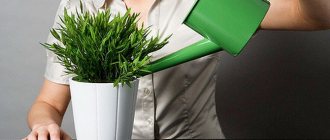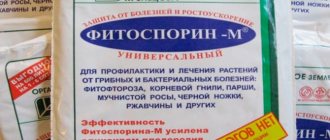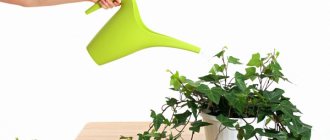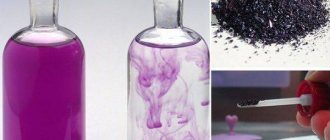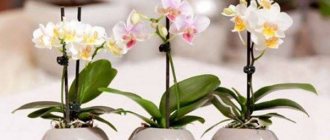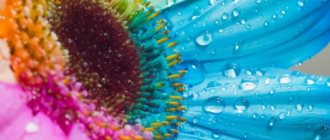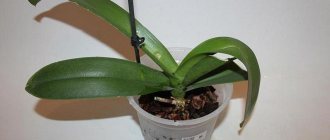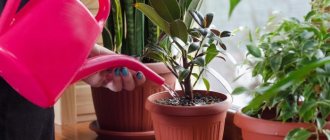The table shows signs of lack or excess watering of houseplants.
Wet, may have a sour or musty smell, the smell of mold, there is water in the pan.
Slowdown. Increased growth of green mass during the flowering period.
Tender leaves droop and become limp. Dense, leathery leaves dry out. The old leaves fall off first.
They droop, turn yellow, the tips turn brown, there are softened areas with signs of rot. Both young and old leaves fall off.
| Signs of lack of water | Signs of excess water | |
| The soil | Dry, cracked, hard, falling away from the walls of the pot. | Slowing down or stopping |
| Condition of the leaves | ||
| Condition of the roots | Drying, thinning. | Rotting, limpness, smell of rot. |
| Condition of buds and flowers | They wither and/or fall off quickly. | Presence of mold. |
Growing plants hydroponically will help you avoid underwatering or overwatering. Read about this in the article: What is hydroponics?
Why is it undesirable to water with hard water?
If irrigation water is too hard (tap, spring, well), the pH of the soil changes towards alkalization.
This leads to a disruption in the absorption of phosphorus, iron, manganese, boron and other important elements by plants. The high content of calcium and magnesium salts in water leads to the fact that these elements turn into compounds inaccessible to plants, and the absorption of iron, which is necessary for photosynthesis, is blocked.
Houseplants develop chlorosis - the leaves lighten, then turn yellow and die. The soil may emit an unpleasant putrid or sour odor, which indicates rotting of the roots. In this case, be sure to transplant the plant into another soil, removing the rotten roots. The consequences of watering with hard water are also the formation of a white crust on the surface of the soil and white stains on the walls of ceramic pots.
Hard water has a particularly detrimental effect on aroids, ferns, camellias, orchids and azaleas.
Water for watering indoor plants
Houseplants are like children, each with their own character and mood. One likes to be frequently turned around an axis, the other, on the contrary, try it, move it from place to place, and the bud will fall off without ever blooming.
But from excess or lack of moisture, green pets are capricious in different ways: either restrainedly drooping their leaves, or desperately dying.
Any gardener knows that it is not worth watering flowers with immediately collected tap water; it contains harmful substances used by our domestic industry for disinfection. Therefore, you should pour water into the container and let it sit for several hours or days.
It is also not recommended to water with boiled water - it is “dead” and does not have dissolved air or microelements. There will be no harm, but no benefit either. As for rain or melt water, it has always been considered optimal for irrigation. But now it is necessary to make allowances for the state of the environment.
In today's environmental conditions, it is preferable to water indoor flowers with artesian drinking water, but not with mineral water.
Experienced gardeners advise using aquarium water for irrigation, and if you take its bottom layer, you can combine watering with fertilizing, since sludge has always been a good fertilizer. But it is worth remembering that you will get beautiful, juicy leaves on the flowers, but they may refuse to bloom - and there should be a measure of fertilizer. After all, if there are a lot of fish and little vegetation in the aquarium, there will be excess nitrogen in the water.
When talking about water, it is necessary to seriously focus on water hardness. Hardness is the capacity of calcium and magnesium salts per unit volume of water, expressed in mEq/l.
Define:
- soft – up to 3 mEq/l
- medium hardness – 3-6 mEq/l
- hard – more than 6 mEq/l
- very hard – over 9 mEq/l
Watering with hard water has harmful effects on plants, namely:
- the accumulation of calcium and magnesium salts changes the acidity of the soil towards an alkaline reaction - camellias, azaleas, ferns that prefer acidified soil die;
- difficulty in normal absorption of essential nutrients by plants;
- reduction of resistance to non-infectious diseases - spotting, dry and wet rot.
Criteria for selecting water for watering home flowers
Not every water that is used to water a houseplant has a beneficial effect on it. Therefore, quite often there are cases when, after prolonged watering, a seemingly healthy young plant begins to turn yellow, fade, or even disappear completely. Many people may not even immediately guess what this is connected with. But it's all about the water.
It is necessary to water indoor flowers with water at approximately room temperature, with a minimum amount of harmful impurities, and of course, with a neutral pH level. It is by these 3 criteria that the suitability of water for watering home flowers is determined. Let's talk about each point in more detail.
Water temperature
Why is it so important to water indoor flowers with water at a certain temperature? The answer is simple - fragrant indoor plants may simply not tolerate a cold shower or watering with warm water, especially if the flowers are overly sensitive. Therefore, it is very important to let the water reach room temperature. This is an ideal option for watering indoor plants.
Whatever water you take: tap water, rain water, etc., you must adhere to the temperature rules. Otherwise, if you water the flowers with cold water, the roots of the plants will experience a certain shock, and this will have a detrimental effect on their development. The flowers will either begin to grow more slowly or completely dry out and die.
Warm water is also taboo for watering indoor plants, with the exception of some flowers, for example, orchids during flowering. Therefore, do not forget to defend it and bring it to the desired temperature. Your plant will definitely thank you for this with its blooming appearance and unfading beauty.
Chemical composition of water
The presence of chemical impurities in the water is of no small importance when watering indoor plants. We are talking about chlorine, all kinds of heavy metals, etc.
These impurities are far from safe for flowers, since they settle primarily on the roots of plants and violate their integrity. All this leads to premature wilting of the flower. Therefore, when choosing water, it is important to take into account the place from which it comes.
If you use rainwater to water your flowers, try to use only that which was formed as a result of heavy, prolonged rains. If the rain was short-lived, there is a high probability that the melt water contains many harmful, even toxic, substances. This mainly applies to industrial areas and places located near highways.
Along with such rains, harmful substances released into the atmosphere by factories and transport will fall. And only if the rains are prolonged, then not the first portion of flowing water may be suitable, and most importantly, safe for indoor plants.
Particular attention should be paid to tap water. It contains chlorine - the main enemy of all life on the planet. Houseplants are no exception. When chlorine gets on the root or leaf of a flower, it mercilessly kills the plant.
In addition to chlorine, tap water contains a huge amount of salts. As a rule, these are chlorides, well-known to many, which harm the growing plant, depriving it of its vital potential. Therefore, the water from the water supply that will be used to water the flowers will need to be settled or diluted. You should not immediately pour water that has just come out of the tap into flower pots.
Hardness of water
One of the most important criteria for water selection is its hardness level. Hardness depends mainly on the presence of so-called alkalis in the water. They often mean dissolved carbonates, usually magnesium and calcium. And the more dissolved salts of such metals are in the water, the harder it is.
To determine the hardness, you need to make a request to the water supply station, of course, the local one. Because water hardness is not the same in every area. But, if it is not possible to contact the station, then you can try to determine the alkaline balance of the water yourself, at home. This can be done by examining the flower pot up and down.
As a rule, house flowers are watered with the same water for a long time, that is, either always with tap water, or rain, etc. If the water hardness was high, then over a long period of time during which the flowers were watered with such water, the walls of the pot White streaks must appear. This will indicate that the water contains lime in increased quantities.
An equally eloquent indicator of excessive rigidity is leaf chlorosis. This is due to the fact that an overly alkaline soil environment blocks the access of nutrients directly to the plant itself. For this reason, the leaves of the flower first begin to lighten and then turn yellow.
If you find such frightening symptoms in your houseplants, urgently replant them in fresh soil. This will definitely help save the flowers from death.
Acidity
A very important factor in water for irrigation is its acidity level. It can be determined using litmus paper. This must be done in advance, before the watering process begins. Increased acidity of water has a detrimental effect on the house plant, especially if it is very sensitive. Such sensitive plants include hydrangea, camellia, orchid, etc.
Each individual type of flower has its own acceptable level of water acidity. If the irrigation “material” does not meet the standards, then it must be adjusted and brought to the required parameters. To do this, you can drop simple lemon juice into some water. It will help reduce high acidity to the required level.
Water that should not be used to water flowers
- Well water. It often contains too many minerals, and this negatively affects the plant. Flowers, of course, need useful minerals, but an excess of them will not benefit the plants.
- River or lake water. These types of waters are least suitable for irrigation. They contain various bacteria, viruses, rotting products and even waste. No matter how you settle and purify such water, it will still not be useful or safe for indoor plants.
- Distilled water. It is considered “dead” because it is completely devoid of minerals, vitamins and salts. And for the development and growth of home flowers, all these substances, in reasonable quantities, are simply necessary.
- Water from the air conditioner formed as condensation. Its qualities are very similar to distilled water, and such water, as we know, will not bring benefits to plants.
All of the above types of water apply to watering all plants, without exception, even overly “capricious” and sensitive ones. For example, an orchid is a delicate and special flower that requires constant attention and careful, and most importantly, proper care. But even despite this, all of the above watering rules are fully applicable to it.
Main arguments on the topic
An autonomous water supply system is certainly very convenient and cost-effective. Water from there is used for both domestic and economic needs, and if the temperature of the moisture is not particularly important for household chores, then the question of whether it is possible to water the garden directly from a well is very pressing.
The advantages of using water from an artesian well include:
- Environmental cleanliness and safety;
- Absence of harmful impurities and toxic elements;
- A practically inexhaustible resource (regardless of weather conditions and centralized water supply);
- High level of productivity (watering endless plantations from one well).
The disadvantages of this type of source include:
- Saturation with minerals, which requires the installation of a multi-stage filtration system;
- The temperature is too low, which is unacceptable for irrigating the garden in many respects.
Most experienced agronomists agree that too cold moisture will not benefit the plants. If you water with water that is not warmed up, there is a high risk that the plants will not receive the necessary nutrition, even if the soil is apparently very moist. From above, the soil seems well saturated, but the delicate roots are not able to absorb moisture at this temperature and the plant continues to experience severe thirst, which is manifested externally by lethargy, yellowing and loss of turgor, and, subsequently, the complete death of the crop.
Gardening and ornamental crops experience a real shock from the effects of icy liquid. The water should be settled and heated to the ambient temperature (with a difference of no more than 1...2 degrees) - this will help avoid stress and provide the root system with the necessary amount of moisture.
Tap water
If the source is a river, then you can use tap water, pre-settled for at least overnight, at room temperature (22-25 degrees). During this time, the chlorine present in the liquid will evaporate. Most often, the waters of rivers and streams contain calcium and magnesium salts.
Their level affects water hardness. When water is very hard, plants cannot absorb important elements from the soil: manganese, phosphorus, aluminum, iron, boron. Therefore, you need to use methods to reduce hardness by adding appropriate preparations or distilling through a filter or boiling.
White stains and even the appearance of a crust on the surface of the soil and pot indicate great hardness.
And the plants themselves begin to signal the hardness of the liquid. Magnesium and calcium salts prevent plants from absorbing nutrients. The leaves of the plants begin to lighten and gradually turn yellow. Having discovered a similar symptom, the indoor flower should be transplanted into new soil. The following are especially sensitive to hard water: anthurium, azalea, fern, orchid, camellia, bromeliads, and aroid families.
If water comes into the water supply network from a well, it can be very hard and it is not advisable to use it for irrigation without preliminary treatment.
Preparatory work
Having figured out that you can water your garden with well water only after heating, it is important to learn simple techniques for preparing moisture before use.
- Water from a well, well, or source is poured into a bulk container (it is convenient to use a metal trolley or barrel painted on the outside in a dark color, which will allow the container to warm up faster).
- The container is placed in a sunny area of the garden or left in a greenhouse for at least 12…24 hours (during this time the water has time to settle and warm up to ambient temperature). It is not recommended to cover the container (if there are harmful volatile substances in the liquid, they will evaporate faster).
- Use this water for irrigation in the morning or evening, when the sun is not particularly strong. Irrigation is allowed during lunch hours if the weather is dry
The choice of water for irrigation depending on the plants
Most indoor plants respond well to watering with soft water of a neutral or slightly acidic reaction, but some plants have special requirements for the composition and acidity of the water.
Heathers, rhododendrons, azaleas, fuchsias, monsteras, ferns prefer a medium acidic substrate. Pelargoniums, begonias, abutilon, tradescantia, and gerberas grow well in slightly acidic soil. To ensure that the acidity of the soil does not change and remains optimal for plants, water for irrigation must be acidified.
Neutral soil is suitable for most plants, so water for irrigation can simply be cleaned of hard salts.
Much less often on windowsills you can find plants that prefer slightly alkaline soils, for example, some types of lady's slipper. They can be watered with alkaline water with a high calcium content as they are calciphyles and grow naturally on chalk rocks.
Most plants can tolerate a certain concentration of salts, but epiphytes (bromeliads, orchids) require the most purified water, close to distilled.
When watering plants, regardless of their species, you should always give preference to soft water.
You can always find a way to help purify and soften tap water, because the life expectancy and decorative value of any indoor plant depends on it.
Is it necessary to heat water from a well before irrigation?
With drip irrigation, the water has time to warm up in the air.
Experts assure that heating is the only way to protect the garden, lawn, and vegetable garden from destruction. Special storage tanks are filled with well water. The liquid should settle in them for about a day or more. During this period of time the following will happen:
- The water will warm up to the optimal temperature. As a result, shock is avoided in plants when irrigated.
- It will be saturated with oxygen, become alive, suitable for moistening the soil and the root system of crops.
- It will settle, as a result of which all iron ions oxidized by oxygen will precipitate. This does not require an expensive cleaning system.
- Carbonate salts will linger on the walls of the storage tank.
- The density of water changes with height. Its upper layers will be less mineralized. Moisture from this part of the storage tank should be used.
This results in a natural purification of the liquid. It is advisable to have such a volume of storage tanks that you can gradually add new liquid to them, taking some of it earlier.
It is permissible to ignore the temperature regime if water is supplied using aerators. Liquid droplets warm up in the air before falling onto the ground.
To properly moisten the soil in the garden, vegetable garden, or lawn during the hot period, 500-1000 liters of water should be used per 1 hectare of land.
Gift from heaven
When you are faced with a dilemma whether it is possible to water indoor flowers with boiled water, or whether it is better to use tap water, you end up with a choice of two evils. Of course, it is best to choose less, but there is no definite answer here, it all depends on the specific plant and its needs.
Therefore, you can simply choose the third option. Rainwater can become this way. You need to collect it when it rains for the second day in a row. This rule applies only to urban conditions, since on the first day all the harmful substances that got into the clouds fall out.
Methods for preparing water at normal temperature
All competent summer residents, gardeners and vegetable farmers use a simple method. First, they pump water from a well or water pipe into a special container. There it settles and heats up naturally. The degrees reach the level of air temperature. Infusion time is about a day, maybe a little less. In the evening, we watered the garden from a container, filled it with water again, let it sit the whole next day, and watered it again in the evening.
Types of water tanks:
- plastic tanks;
- wooden barrels;
- metal tank;
- cast iron trolley;
- any other capacious tanks.
Prudent gardeners and gardeners additionally keep another container - for rainwater. Rainwater is considered the most suitable source of comfortable moisture supply for any plants. Especially if it also sits for about a day. It is easy to alternate both tanks - with water collected from a well (pipeline) and with rainwater during use. Interchangeability plays a big role here - water is settled in one tank and used from another.
The water settles in containers, deepening the pump hose to a level below half Source psy-files.ru
Adding peat
You can reduce the hardness of water for irrigation using peat. For this you will need 100 g. fresh peat and 10 l. water. It is with these proportions that the result will be more significant.
So, we put the peat in a linen bag, and then put it in a container with water for the whole day. If you don’t have time to wait, and you need water right now, then make your own peat filter and pass a portion of fresh water through it.
To make a filter, take a flower pot (preferably large) with a drainage hole. Then place a linen napkin at the bottom of the pot (the cloth should be rough), and pour loose peat on top of it. Fill the flower pot to the top. After this, place the container with peat above the empty bucket.
Fill another bucket with water and pass it through a peat filter. All the water that flows into the bucket from the filter will be suitable for irrigation. By the way, adding peat will help not only soften the water, but also acidify it.
How to soften water for irrigation
There are many ways. The simplest ones for home use are the following:
- Add charcoal to the settled water at the rate of 3 g per 1 liter of water (oak and chestnut wood cannot be used to produce charcoal);
- A fabric bag filled with 100 g of fresh peat is placed in a 10-liter container for a day - then you can even wash your hair with this water.
If the home plumbing system is equipped with a filter for purifying drinking water, the problem of hardness is eliminated; filtration usually removes calcium and magnesium salts from the water.
There is also a chemical method of softening water; quite often this method uses oxalic acid, but there is a serious caveat - you need to know exactly the hardness of the water - otherwise the slightest imbalance will cause an undesirable reaction in indoor plants. A digital tester for determining hardness can be purchased at a flower shop or online store.
Acidified
If you don’t have time to settle tap water, then you can soften it in one simple way, simply by adding lemon juice or a couple of grains of citric acid.
Acetic acid is also used. To prepare the solution, you need to dissolve 15 drops of table or apple cider vinegar in a liter of water.
Oxalic acid also does an excellent job of softening liquids. You need to add 30 grams of acid per liter of water and leave the solution for about a day at room temperature.
What kind of water do flowers need?
If we look at the natural conditions for growing flowers, they are all watered with rainwater.
In terms of its composition, such water does not contain any admixtures of dissolved salts and minerals. She is very soft, her Ph is 5.6.
What kind of water flows from our tap? Brrr. There are almost no regions with soft water in Russia.
Basically, everywhere there is hard water, the same water that kills our washing machines, kettles and dishwashers with scale. So, do you think it will suit plants?
It is already becoming clear that watering with tap water should be avoided. Settling and boiling does not solve the problem of hardness of such water, and the Ph of such water is about 7-8, which is far from the preferences of plants.
With this in mind, I tried to water my plants with filtered water: mostly it was water from a Barrier brand pitcher filter with a special cassette for hardness, and sometimes I also used filtered water, which we buy bottled near the house.
This water is definitely soft, there is no scale in the kettle after it. But is it suitable in terms of acidity level?
I would still like to check for sure whether I water them with good water? Maybe the flow from my tap is normal, and here I am spending money on filters?
It’s good that I came across Pavel Enikeev’s video on how to test irrigation water at home:
Thank him very much, based on his experience, I conducted my own experiment with my water.
So, I prepared experimental samples. Among them I have (from left to right):
FW - filtered water. We buy this water for money to bottle near our house (60 rubles for 20 liters).
KR - Tap water.
Barrier - Water filtered through a Barrier brand pitcher filter with an anti-hardness cassette.
FN - Frutonyanya. I don’t water it with it, it would cost a pretty penny. But sometimes I root cuttings in it.
Kip - Boiled tap water.
The only thing I lack is water from a reverse osmosis filter, which Pavel Enikeev considers the best for irrigation and proved this in his video.
The water passed through the membrane filter is the purest - very soft and with a Ph of about 6, which after boiling increases to 7 (the norm for humans).
For now, I only have such a filter in my plans, so I’ll work with what I have.
So, all samples are at the same temperature, the red cabbage is finely grated, everything is ready for research.
Place a pinch of cabbage in each glass.
I stir with my finger. And now, you can evaluate the results.
As I understand it, our task was to find water with the most suitable pH level (closest to rainwater, which has a value of 5.6).
Cabbage juice turns rainwater and reverse osmosis water purple-pink. It should be taken as a standard.
Boiled water turned out to be the bluest. This suggests that it is categorically unsuitable for watering flowers.
As experiments that people did before me show, boiling does not soften water, or reduces it slightly, but it even increases acidity.
And such water is not suitable for your flowers in any way; in fact, it turns out even worse than just tap water.
Filtered water for bottling and tap water were not far from it. They don't fit either.
The filtered water we buy is soft, after which there is no scale in the kettle at all, but nevertheless, in terms of acidity level, it is not suitable for plants.
Frutonyanya and Barrier have gone purple-pink, they are a little better. The barrier is even pinker than Frutonian.
So it turned out that, in principle, I was right when I watered my flowers with filtered water from it.
But still I can’t say that the result completely satisfied me.
For lack of a better option, you can use a pitcher filter, but still the best option is to install a reverse osmosis filter.
These are my results.
Therefore, I advise all gardeners, especially those whose flowers wither and die for unknown reasons: pay attention to what you water them with. Perhaps your water is completely unsuitable for them.
Source
Watering orchids
One of the most important conditions for successfully growing orchids is water quality. Water for plants is not only a source of food and drink at the same time, but also an opportunity to regulate their temperature.
In nature, plants use rainwater, which is an ultra-weak acid solution. But, unfortunately, it’s no secret that in cities, a far from harmless liquid is pouring from the sky.
For orchids (and for other indoor plants) it is recommended to use soft or moderately hard water . Measuring water hardness is not a simple procedure, so let’s take it as an axiom that in St. Petersburg and the Baltic states the water is soft, in Moscow it is moderately hard, in Kyiv it is very hard. The faster a layer of scale forms in your kettle, the harder the water.
The simplest way to reduce water hardness is to boil it , during which some of the calcium salts precipitate. Oxalic acid reduces hardness well (you can buy it in chemical stores, sometimes in flower shops, for example, I saw it in the Violet House on Nagatinskaya Street). This is done like this: Add about 1/8 teaspoon of acid (it’s in powder) to a 5-liter canister of cold tap water. We settle the water for 24 hours in an open container; it is even better to cut off the very top part of the canister to enlarge the neck. The water must be kept open due to the fact that during the chemical reaction of binding calcium salts, volatile chlorine compounds are formed, which must evaporate. After a day, an insoluble precipitate of calcium salts falls to the bottom of the canister. The resulting water should be carefully poured into a clean container, trying not to stir the sediment. Just in case, I never pour out the water completely - I leave about half a liter so that no sediment gets in. The canister should be transparent - this makes it easier to monitor the sediment. In my practice, if water with acid sits for more than 2 days, the sediment stops agitating and it is safe to drain clean water.
Another method is to immerse a bag of high-moor peat in a bucket of water overnight - this also acidifies the water.
If you water your plants with distilled water, remember that it is completely desalted. Therefore, distilled water must either be mixed with regular settled water, or special fertilizers must be dissolved in it .
Iron water is even more dangerous for orchids than hard water. When this water settles, it becomes cloudy and has a noticeable taste of rust.
An equally important condition for the suitability of water is its acidity. Acidic water - a pH value less than 5 is very rare. Alkaline water can be easily acidified using regular lemon. If your water shows a pH above 7 (you can measure it either with pH meters or with litmus paper - sold in chemical stores), then by dripping lemon juice you reduce the pH value to 6, and measure how many drops you need for what volume water flowing from your tap.
It is useful to saturate properly prepared water with oxygen before watering - to do this, you just need to pour it in a thin stream from one container to another. The water temperature should be room temperature or slightly higher. Phalaenopsis, for example, prefer warm water.
The easiest way is to either use filtered water or water your plants (including bonsai and orchids) with store-bought water. An option is to buy special oxygen water, which is good for both humans and animals and plants; an example of such water is oxygen royal water, sold here.
Amount of water for irrigation
When watering indoor flowers, you should never forget about the amount of water. You need to figure out what type of watering your plant requires - abundant, moderate or sparse, and remember - in summer the soil dries out faster, therefore, the plant needs more intensive moisture than in winter.
Abundant - the soil should always remain moist, but the top layer should dry out between waterings. Spathiphyllum and monstera require abundant watering.
Moderate - the top layer of soil should dry out 2-3 cm between waterings. This is how ficus, dracaena, orchids, and aloe are watered.
Rare - the soil should dry out by about 2/3, but not dry out completely. Cacti and other succulents require infrequent watering.
Finally, there are two restrictions for watering:
- the soil should not be too wet even for moisture-loving indoor flowers, except for a few minutes after receiving moisture;
- the soil in the pot should not dry out too much, even for drought-resistant plants, with the exception of cactus.
What should the water temperature be?
Water for irrigation should not be too cold. In this case, it can cause rotting of roots and stems, falling of buds and leaves, because root hairs practically stop absorbing moisture.
The optimal water temperature for irrigation is the ambient temperature or 2-7°C higher. Heated water is necessary primarily for all tropical plants and cacti. It has been found that it accelerates the flowering of gloxinia, hippeastrum, amaryllis, pelargonium, hydrangea and other flowers.
It is unacceptable to water plants that are dormant in cool rooms with warm water.
If you liked the article and do not want to miss other useful materials, I invite you to join the group of regular readers and subscribe to site updates.
Author: Ilona Khomych, FlorisMania.com
Bookmark / Share with friends:
Is it possible to water flowers with beer?
Flower fans on forums discuss not only what kind of water is suitable for watering indoor plants, but also what else to irrigate their pets with.
Gardeners know about the benefits of yeast - they are used as a top dressing.
Yeasts are fungi. In the ground they awaken microorganisms that actively process organic matter. A lot of nitrogen and potassium are released, which are necessary for green spaces.
The soil in a flower pot is quickly depleted, and yeast comes in handy here. They are found in abundance in beer. Without even doubting whether it is possible to water flowers with beer, flower growers practice this method.
The beer method is beneficial only if the drink is “alive”. Preservatives and stabilizers, which preserve bottled beer for up to six months, are harmful to plantings.
The indoor rose is considered a beer “admirer”. Money trees, dracaenas, and spurges are tolerant of such moisture.
Important! Before watering, “live” beer is diluted with water in the ratio: 1 part intoxicating drink to 10 parts liquid.
Is it possible to water indoor flowers with water from an aquarium?
An aquarium is a closed ecosystem. Microorganisms and bacteria live in it. Dissolved minerals, vitamins, humic acids. The liquid is warm and oxygenated. Inhabitants are fish and snails, which add urea.
Water from an aquarium is no longer just life-giving moisture, but an organic substrate.
Regarding its use, the opinions of flower growers are completely opposite. Some consider aquarium substrate an elixir for moisture-loving species. They notice the lush flowering and lush greenery of the potted inhabitants. Others are not seeing fantastic growth.
Even specialists are not enthusiastic about the method. The undoubted benefits are considered:
- temperature of the irrigation liquid;
- savings on fertilizing;
- oxygen saturation;
- no chlorine.
But it cannot be called clean, even despite the filters. There will be no harm to plants from aquarium liquid if you moisten the soil periodically - once a month.
Important! Before watering, the aquarium substance is aerated by blowing atmospheric air through the water column with an aerator.
Aquarium - organic substrate
Possible cases
There are exceptions to the question of whether it is possible to irrigate with water from a well. This procedure is acceptable for a drip system, when moisture is measured and very carefully delivered directly to the root system.
Also, the option of direct watering is acceptable for autumn feeding of fruit and ornamental trees before wintering. The air temperature in October and November (depending on the region) approaches zero, which opens up access to the use of well water directly from the source without additional heating.
Is it possible to water indoor flowers with serum?
People are returning to nature, everything natural: fabrics, food, drinks. This slogan was transferred to home flora. Now the question is no longer which liquid to choose for irrigation. They take natural products, without pesticides and chemicals. Whey came under the gun. And for good reason.
The whey is acidic. Useful substances: amino acids, trace elements, phosphorus, potassium, lactic bacteria. An invaluable fertilizer and pest suppressant. An undiluted product will damage the flora and disrupt the soil balance. Suitable ten times mixed with liquid. This is the base solution.
- Add 0.5 kg of sugar per 10 liters and a pinch of yeast to the whey solution. Fill the cut grass.
- Dissolve iodine in diluted whey (10 drops per 10 l), add ash.
To water under the roots, dilute 1 part fertilizer in 10 parts of liquid. For spraying, take 1 liter of solution for 3 liters of water.
Important! In a dormant state, plants are not fed with whey.
Serum for watering a home greenhouse
In the garden
When planting vegetables in open ground beds, rain will come to your aid. However, precipitation does not always replace watering. Be sure to check to what depth the soil is wet after rain. Long, calm rain is good for vegetables, but a heavy, but short downpour most often will not give a good result, it will only refresh the plants.
For some plants, in a favorable year, if precipitation occurs periodically, natural watering is sufficient. Such unpretentious crops include pumpkins, zucchini, squash, peas, and potatoes. In hot and dry weather, you will have to water them too, so as not to lose the harvest.
Other vegetables require watering to a greater or lesser extent. Its frequency depends not only on the crop’s requirements for moisture, but also on the specific conditions of your site. Light, sandy and sandy loam soils require more water and it drains away faster.
Article on the topic
Stop the invasion. How to protect your garden and garden from pests?
Possible dangers
When irrigating garden crops with water from a well, plants face various dangers. The most common of them are temperature shock and oversaturation with minerals, which results in the death of the crop.
Temperature
As a rule, liquid from a natural source is supplied with an indicator of +8 – +14 degrees (in summer). The owner of the plot irrigates the crops in the warm season, when the soil is warmed to at least +22 degrees. More often than not, it is incredibly hot outside and the ground is hot. Under such conditions, ice water falling on the root system of the crop causes its temporary paralysis. The supply of moisture and nutrients to the above-ground part of the plant is stopped for some time. At the same time, the leaves of the crop continue to grow and evaporate. Such processes often cause rupture of thin streams of water in the capillaries of plants. As a result, everything that is above this zone dies. The phenomenon is called apoplexy among professionals. The most gentle crops in terms of water temperature are:
- strawberry;
- strawberries;
- raspberry and currant bush;
- tomato;
- zucchini;
- cucumber;
- greenery;
- potato.
The discrepancy between the soil temperature and the moisture supplied for irrigation should not exceed 5 degrees. Professionals recommend moistening the soil and plants in the evening or at night, or in the early morning hours. At this time, the sun does not burn the foliage of plants through small lens drops formed after abundant irrigation of the area.
Mineralization
Excess minerals when watering a lawn with water from a well also do not benefit the vegetation. Vegetables, berries, and fruits often die from excess iron and calcium. Moreover, garden and vegetable garden owners observe a characteristic yellowness or rust on the leaves. Such impurities destroy plants and negatively affect the quality of the crop. Vegetables, berries and fruits grown in such conditions are extremely dangerous for both humans and animals.
If the analysis shows excessive saturation of the liquid with minerals, it is better to immediately install a good water purification system, because the owner of the site also uses it for domestic purposes.
Calcium and iron have a particularly negative effect on the following crops:
- coniferous trees;
- Apple tree;
- viburnum and rowan;
- hydrangea;
- lily of the valley;
- maples and other lovers of acidic soils.
In addition to the fact that iron impurities have a negative effect on the soil and crops, it also very quickly damages all nozzles and other metal elements of the irrigation system. The same effect is observed from resources oversaturated with chloride salts or limestone. You can't water it with salt water at all. All living things will gradually die.
Manganese seriously burns the soil. Later it becomes unsuitable for planting and growing plants.
Oxygen saturation of water
The moisture supplied from the well is practically not enriched with oxygen. It is not advisable to irrigate garden and garden plants with such liquid. The exception is when water is supplied through drip irrigation systems or sprinklers. If watering is carried out through a hose directly from the source, there is no need to talk about saturation of the O2 resource.
To saturate the water taken from the well with oxygen, you need to make special settling tanks for it: large barrels, vats, a swimming pool. First, they are filled to the top and the liquid is allowed to be saturated with life-giving gas.
We water the flowers correctly!
Just as a person is unable to live without water and food, the life of representatives of the plant world is unthinkable without watering. The need for water varies among different plants and is determined by their characteristics: the structure of the stems and leaves, the power of the root system, etc.
Water for watering flowers must be neutral in its acid-base state and contain as few harmful impurities as possible (salts of heavy metals, chlorine, fluorine, etc.). The acidity of the water (pH) is of great importance. The pH value is a measure of the amount of free hydrogen ions contained in water.
Increased or decreased acidity can not only harm the health of the plant, but also lead to its death. The pH of drinking water ranges from 6 to 9. And the pH of water for irrigation should be in the range of 5.8 - 6.2. It is convenient to control the pH of water using the device “electronic pH meter KL-009(I)
A", which can be purchased in our store. You can use it easily, just do not forget to calibrate it monthly to improve the accuracy of measurements. You can also purchase the calibration solution from us. In addition to an electronic device for measuring pH, you can use a liquid ph test.
Measurement range from 4.0 to 8.5. The test is highly reliable and low priced. By adding two drops of the test to a test tube with the test liquid and comparing the resulting color of the solution with the color chart attached to the test, you will instantly get the result and be able to adjust the acid-base state of the water for irrigation.
Read a more detailed article - What is ph
